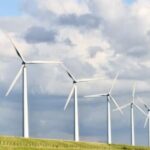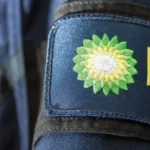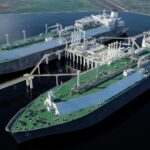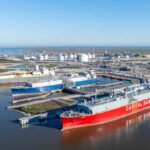Energy News Beat
The malaise spreading through the renewable energy industry hasn’t come to an end just yet.
wind energy giants Ørsted A/S and Siemens Energy are facing billions of euros in losses and writedowns as their wind energy businesses continue to deteriorate.
Siemens Energy is currently in talks with the German government looking to secure as much as €16B worth of guarantees for long-term projects after the company warned that losses at its troubled wind turbine business are likely to be higher than earlier forecast.
The malaise spreading through the renewable energy industry that started in late October when we reported that shares of Israel-based SolarEdge Technologies Inc. (NASDAQ:SEDG) suffered their biggest crash in the company’s public history has now spread to the European wind energy sector, too.
It’s all about soaring costs and supply chain woes–all of which prompted SolarEdge to warn that Q3 revenues, gross margin and operating income would all come in below the low end of the company’s prior guidance.
Now, wind energy giants Ørsted A/S (OTCPK:DNNGY) and Siemens Energy (OTCPK:SMEGF) are facing billions of euros in losses and writedowns as their wind energy businesses continue to deteriorate.
Ørsted, the world’s biggest builder of offshore wind parks, has raised the alarm on possible impairments of as much as 28.4B Danish kroner (US$4B) to its U.S. portfolio thanks to supply chain snarls as well as an unsuccessful bid to seek more profitable contracts with New York regulators.
The company has also scrapped two New Jersey wind projects; 2,248 MW Ocean Wind 1 and 2 projects, but says it will move forward with its Revolution Wind project offshore Connecticut and Rhode Island, a 50-50 joint venture partner with Eversource. Ørsted has forecast a third-quarter loss of 12 billion kroner, the worst quarterly loss since 2015 when the company was more focused on fossil fuels and conventional electricity.
Two weeks ago, Ørsted announced that it has agreed to sell 50% of the Gode Wind 3 offshore wind farm in Germany for €473M (nearly $500M).
‘‘Ocean Wind 1 and 2 have experienced significant impacts from macroeconomic factors, including high inflation, rising interest rates and supply chain constraints, particularly a vessel delay on Ocean Wind 1 that considerably impacted project timing,” Ørsted has said.
“Orsted is a big player in the renewables world and was one of the frontrunners, so there is a conception in the market that what the company is facing today are actually issues that could be seen across other developers,” ABN Amro Bank NV strategist Larissa Fritz has told Bloomberg.
Ørsted is hardly the only wind energy developer in serious peril. Norwegian energy giant Equinor ASA (NYSE:EQNR) took a $300 million impairment on U.S. offshore wind projects while China’s top turbine maker Xinjiang Goldwind Science & Technology Co. reported on Friday that third-quarter profit tumbled 98%.
Ørsted shares have crashed 61.3% in the year-to-date to a five-year low.
“There are too many known unknowns around Orsted, which could lead to near-term headwinds for its shares. Visibility around the US, including balance sheet funding, and the fate of Hornsea 3 is required before any meaningful re-rating,’’ Citigroup Inc. analysts have said.
Meanwhile, shares of Ørsted’s German peer Siemens Energy have jumped nearly 13% in Wednesday’s intraday trading after supervisory board chairman Joe Kaeser said the company does not need a taxpayer-funded bailout from the German government, and that it seeks guarantees rather than a cash injection.
“The company obviously doesn’t need money from the state,” Kaeser reportedly told the Welt am Sonntag newspaper, adding that “all segments apart from the wind business are doing well, partly better than at the competition. If you read ‘state aid’ as an investor, then panic is pre-programmed”
Siemens Energy is currently in talks with the German government looking to secure as much as €16B worth of guarantees for long-term projects after the company warned that losses at its troubled wind turbine business are likely to be higher than earlier forecast. Siemens says it needs the backstops for projects because the financial outlook for its wind turbine business has continued to deteriorate. Back in June, the company announced that it was overhauling the division at a cost of up to €1bn.
Cost Increases
According to Kerstin Ahlfont, chief financial officer at Vattenfall AB, these companies have been contending with cost increases of up to 40% over the past 18 months, rendering many projects unprofitable. The Swedish utility itself has been forced to shelve a giant project in the UK after deeming it not profitable enough even with the guarantees available in an auction it won last year.
Last month, no energy companies submitted bids in the UK’s 5GW offshore wind auction, with the government coming under fire for ignoring warnings that the offer on the table was too low to reflect soaring costs. This comes as a significant blow to Rishi Sunak’s plans to meet climate targets and lower energy bills and also makes it harder for the government to achieve its goal of reaching 50 GW of offshore wind by 2030. The price of the UK’s offshore wind power has fallen steeply in recent decades. The government set a maximum price of £44 a MW hour for the latest auction, which developers deemed too low due to soaring construction costs, owing to rising inflation and higher borrowing costs.
Things could not be more different in Germany where European oil and gas supermajors BP Plc (NYSE:BP) and TotalEnergies (NYSE:TTE) won all of the capacity on offer in the country’s 7GW offshore wind auction, its biggest in history. BP secured leases at two North Sea sites off the coast of Helgoland with total generating potential of about four gigawatts, paying a total of $7.5 billion. The new sites–BP’s first offshore wind projects in Germany–will nearly double the company’s global offshore wind pipeline. Meanwhile, TotalEnergies–through local subsidiaries–secured the other two sites for a total of $6.5 billion. Germany currently has 8.4GW of operational offshore wind capacity.
ENB Top News
ENB
Energy Dashboard
ENB Podcast
ENB Substack
The post Europe’s Wind Energy Giants Brace For Massive Losses And Writedowns appeared first on Energy News Beat.








